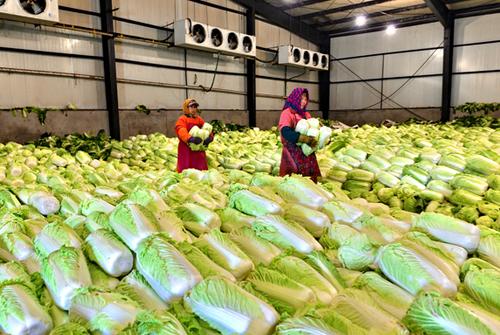O inverno marca a temporada de pico para armazenamento chinês de repolho, E produtores e distribuidores geralmente lutam para encontrar métodos de preservação eficazes. This article will guide you through the process of storing large quantities of Chinese cabbage using refrigerated warehouses to ensure optimal freshness.

Pre-treatment of Chinese Cabbage
When harvesting Chinese cabbage from the fields, select only healthy plants for storage. Optimal specimens feature upright stalks with outer leaves that hang naturally without breaking. After choosing healthy plants, perform necessary trimming. Avoid storing cabbages with visible mechanical damage, as these can quickly rot and compromise the entire batch. Similarly, remove any diseased or pest-infested plants, along with damaged outer leaves and yellowed layers.
Pre-cooling in the Refrigerated Warehouse
Pre-cooling is a critical step in maintaining produce freshness. At [Company Name], we firmly believe that “no pre-cooling, no freshness” when it comes to preserving fruits and vegetables. Regular readers of our previous articles on produce preservation know the profound impact pre-cooling has on long-term storage. Pre-cooling effectively eliminates harmful pathogens and reduces the respiration rate of the cabbage, enhancing its storage performance in the long run.
Before storage, it’s essential to understand the characteristics of Chinese cabbage. With a freezing point around -1°C, the ideal storage temperature in a refrigerated warehouse ranges from -0.5°C to 0.5°C, accompanied by a relative humidity of 90% to 95%.
Storage Requirements at Different Stages
Chinese cabbage requires varying environmental conditions throughout its storage cycle:
1.Initial Stage: During the early storage phase, the primary causes of loss are overheating and leaf shedding due to respiration. Pre-cooling is crucial at this stage, as water loss accounts for 20% to 30% of total losses. Temperature control is the top priority for effective management.
2.Mid-stage: Losses during the middle stage are minimal but still mainly due to water loss and leaf shedding. Cabbages are particularly vulnerable to frost damage, with losses typically around 5% to 10%. Preventing freezing becomes the key focus.
3.Final Stage: After long-term storage, Chinese cabbage may sprout and become susceptible to microbial and bacterial infections, leading to rot. As the storage period nears its end and the cabbage enters its senescence phase, combined with water loss and leaf shedding, losses can reach 10% to 15%. Monitoring and controlling temperature, humidity, and conducting regular inspections are vital.
Controlled Atmosphere (CA) Storage
For those seeking premium storage solutions, a controlled atmosphere (CA) warehouse is an excellent choice. In a CA warehouse, maintain a temperature of around 0°C and regulate the gas composition using specialized equipment: an oxygen level of 2% to 5% and a carbon dioxide level of 2% to 5%, or alternatively, 3% to 5% oxygen and 8% to 10% carbon dioxide. Compared to conventional refrigerated storage, CA storage significantly improves the preservation rate.

Packaging Considerations
Given the high humidity inside refrigerated warehouses, proper packaging is essential. Wrap individual cabbages in plastic bags and store them in crates to prevent excessive moisture from causing decay.
 Provedor de soluções de armazenamento a frio da China
Provedor de soluções de armazenamento a frio da China
